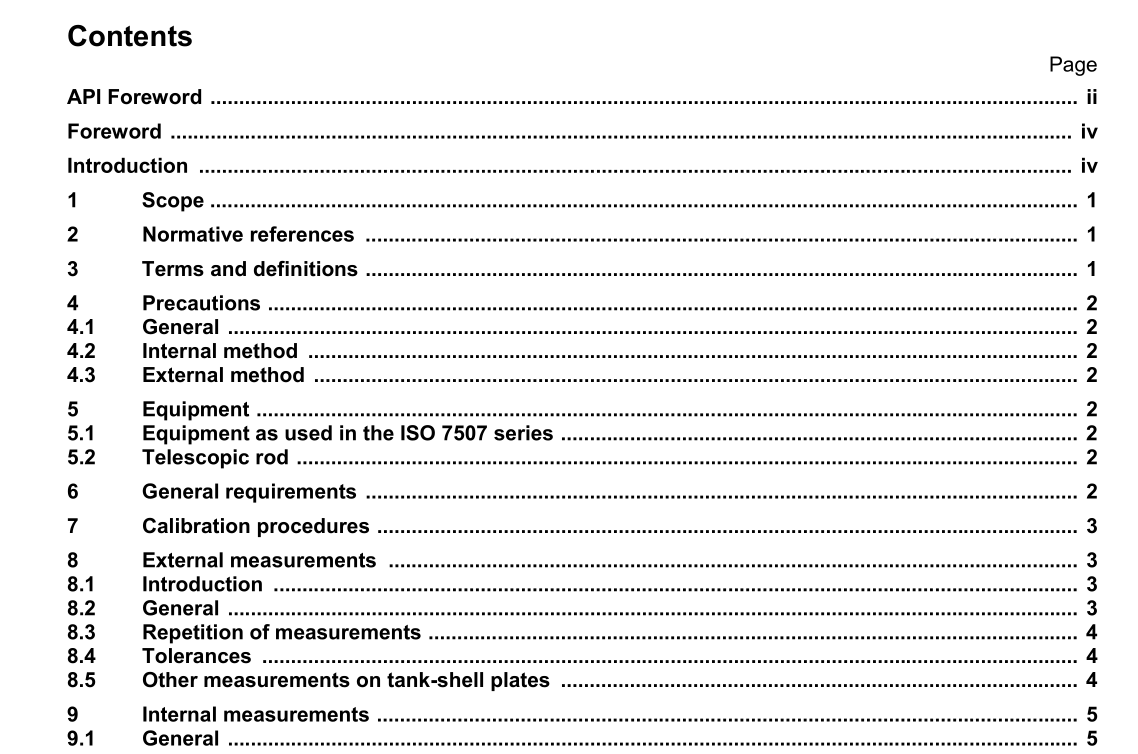API MPMS 2.2E pdf download

API MPMS 2.2E pdf download.Petroleum and liquid petroleum products — Calibration of horizontal cylindrical tanks
1 Scope
This part of ISO 12917 specifies manual methods for the calibration of nominally horizontal cylindrical tanks, installed at a fixed location. It is applicable to horizontal tanks up to 4 m in diameter and 30 m in length. The methods are applicable to insulated and non-insulated tanks, either when they are above-ground or underground. The methods are applicable to pressurized tanks, and to both knuckle-dish-end and flat-end cylindrical tanks as well as elliptical and spherical head tanks. This part of ISO 12917 is applicable to tanks inclined by up to 10 % from the horizontal provided a correction is applied for the measured tilt. For tanks over and above these dimensions and angle of tilt, appropriate corrections for tilt and appropriate volume computations should be based on the “Coats” equation [1].
4 Precautions
4.1 General The general and safety precautions given in ISO 7507-1 shall apply to this part of ISO 12917. 4.2 Internal method Before a tank which has been used is entered, a safe-entry certificate, issued in accordance with local or national regulations, shall be obtained. All lines entering the tank shall be disconnected and blanked. The national or local regulations regarding entry into tanks which have contained leaded fuels shall be meticulously observed. 4.3 External method National or local regulations regarding entry to the tank area shall be observed.
5 Equipment
5.1 Equipment as used in the ISO 7507 series The equipment required to carry out the calibration is dependent on the method to be employed. This part of ISO 12917 uses techniques and equipment described in ISO 7507-1. Equipment used in the calibration of horizontal tanks shall conform with the specifications laid down in the relevant parts of ISO 7507. All equipment shall be traceable to a reference standard. 5.2 Telescopic rod 5.2.1 In addition to the equipment mentioned in 5.1, a telescopic rod shall be used. This telescopic rod shall have a scale capable of being read to 1 mm, and shall be calibrated to within ± 0,5 mm. 5.2.2 The telescopic rod shall give a repeatability of maximum 1 mm.
8 External measurements
8.1 Introduction External measurements may be executed with any depth of liquid and liquid pressure in the tank. The depth, temperature, density and pressure of the liquid at the time of calibration shall be recorded. However, if the temperature of the tank wall could differ by more than 10 °C between the empty part and full part of the tank whilst the measurements are being taken, the tank shall be either completely full or empty during the procedure. 8.2 General For the measurement procedures, a circumferential tape of sufficient length to completely encircle the tank should be used and measurements of the total circumference shall be taken. a) In all cases, the tape to be used should be applied to the tank surface at the prescribed locations by the wraparound procedure; i.e. the required length of tape should be applied in a slack condition, positioned, and tightened by the application of the proper tension.As indicated in Figure 1, strapping should be undertaken around 20 % and 80 % of the course length b) In the case in which the circumferential measuring tape is in contact with the tank surface at all points along its path, circumferential measurements should be made and checked in accordance with the relevant procedure given in ISO 7507-1. The checked measurements should be recorded as final measurements. 8.3 Repetition of measurements After the circumference has been measured, the tension shall be released and the tape brought again to the required level and tension. The readings shall then be repeated and recorded. 8.4 Tolerances Measurements shall be read to the nearest 1 mm and shall be considered satisfactory if two consecutive readings are within ± 0,03 % of the circumference or 3 mm, whichever is greater. If agreement is not obtained, further measurements shall be taken and recorded until two consecutive readings agree. The average of these two readings shall be taken as the circumference. If consecutive measurements do not agree, the reason for the disagreement shall be determined and the calibration procedure shall be repeated.









